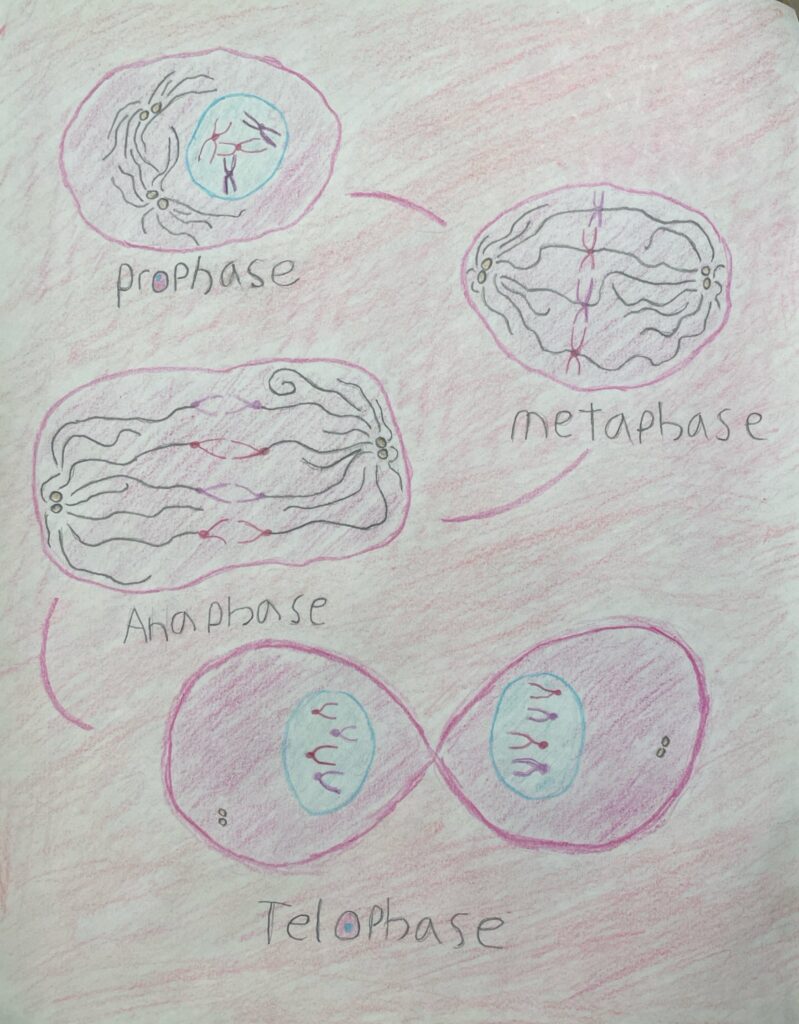For my STEAM project I chose to depict the steps of mitosis, or more specifically how these steps are carried out in cancerous cells. I chose this topic as it hits very close to me, both of my parents are cancer survivors, my dad notably surviving lung cancer. In my research I learned that in cancerous cells mitosis essentially keeps repeating a theoretically infinite number of times.. To represent this I made a drawing of the steps of mitosis, but I drew the last stage, telophase, as an infinity sign to emphasize the infinite nature in which cancer cells can reproduce. Now that a basic understanding of my topic and art piece is layed out I can give more detailed and scientific explanations for the steps of mitosis, and their abnormal repetition can lead to cancer.
To begin I will briefly describe the steps of mitosis as they have been covered in class. The first step of mitosis is prophase. During prophase the cell undergoes several changes. This includes the condensation of the chromosomes, dispersion of the nucleolus, as well as the migration of the centrioles to opposing poles of the cell, and the formation of the spindle apparatus. Immediately following prophase is metaphase. The most important aspect of metaphase is lining up of the chromosomes on the cell’s metaphase plate.
With the first two stages of cell division covered there are two steps left until the single cell has become two identical cells. The third step of cell division is anaphase, during which chromosomes are split in half forming chromatids, which are then pulled to the poles of the cell by spindle fibers. At the conclusion of this stage each end of the cell will contain an identical set of genes.Telophase, the final step of mitosis is when a singular cell splits into two twin cells. To start telophase the nuclear envelope begins to reform in each of the cell’s poles around the chromosomes, which begin to decondense. The spindle fibers disappear and the cytoplasm divides into two complete cells.
In my opinion the way in which cancer affects these steps of mitosis is actually fairly simple. Most healthy cells are able to enter a state called G0 in which they can no longer divide, this is done when the cell has either reached the end of its lifespan or if there are any egregious errors or damage in the cell’s DNA. This and the rest of the cell cycle is regulated mainly by two types of proteins: Cyclins and Cyclin dependent kinases (CDK’s). If either of these proteins fail or malfunction in some way the cell cycle loses all regulation. This not only leads to damaged or malfunctioning cells dividing, but doing so to a possibly infinite degree, as these cells become unable to enter a G0 state. This means when cyclins or CDK’s malfunction there is a high likelihood that the affected cell will undergo the steps of mitosis, a theoretical infinite number of times. This is cancer and has the very high likelihood of forming a tumor.
I was very invested in doing research for this project as it helped me understand exactly what occurred to cause the cancer my parents faced. When I learned that cancer was essentially the endless cell division of diseased cells I knew that my art piece had to symbolize infinity in some way. When I was looking at images of the steps of mitosis I came to the realization that telophase could resemble an infinity sign if drawn in that way and I excitedly drew up some rough concept drafts of what that would look like. I was happy with how it looked so I immediately decided that that’s what my art project would be.

Citations
Mercadante, A. A. (n.d.). Genetics, cancer cell cycle phases – statpearls – NCBI bookshelf. https://www.ncbi.nlm.nih.gov/books/NBK563158/
Ullah, M., Aoudjeghout, W., Pimpie, C., Pocard, M., & Mirshahi, M. (2020, September 18). Mitosis in cancer cell increases immune resistance via high expression of HLA-G and PD-L1. Cancers. https://www.ncbi.nlm.nih.gov/pmc/articles/PMC7564851/
Collins, K., Jacks, T., & Pavletich, N. P. (n.d.). The cell cycle and cancer | PNAS. PNAS. https://www.pnas.org/doi/full/10.1073/pnas.94.7.2776
